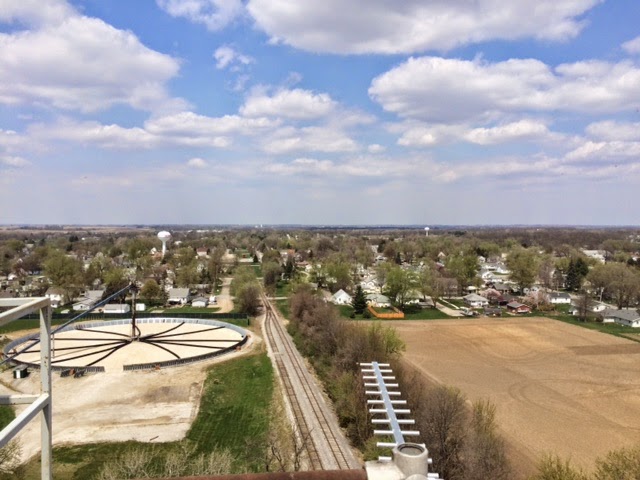 AREDN first site on the air
AREDN first site on the air
I’ve installed the first of what I hope are many AREDN (Amateur Radio Emergency Data Network) mesh nodes. This site is located on a large grain elevator in Heyworth, IL. It’s at the 150 foot level, with two yagi antennas. One antenna is pointed north towards Bloomington, and the other is pointed northeast.
I’m still going some testing with the antenna configuration – with guidance from the AREDN group, it looks like I need point both antennas in the same direction to take advantage of how 802.11 works. I wanted to try to reach two distant locations with this node…the better way to do that is to have two nodes with directional antennas – at least that’s what I’m going to try next.
The node is made up of a Ubiquiti Rocket M900 node, two RP-SMA to N jumpers, and two yagi antennas. The node is fed with a CAT5E cable that provides Power over Ethernet (POE) up to the node, and data in both directions. This arrangement results in very little loss – there’s nearly no coax.
This site also houses a UHF analog repeater and the KD9AKF D-STAR repeater. Using vlan capable switch, I am able to create a connection to the internet from this mesh node. It isn’t meant to be a replacement for personal use internet – but having the ability to route to and from the internet means I can access services from either side of the mesh as allowed by amateur Part 97 rules.
What’s next? I’m working on two more nodes – one is a portable setup that I’m still experimenting with. I’m going to try a 12 mile link to the top of a parking garage sometime. What’s interesting to me is playing in the 900MHz ham allocation. So far, 900MHz for this application behaves much more like microwaves than UHF – it does penetrate some structures and obstructions.















Hello Michael, KG9GE. I would post this comment on your blog, but you require I provide a social media account to post. So I will post this comment here and hope you see it.
You said, “I’m still going (sic) some testing with the antenna configuration – with guidance from the AREDN group, it looks like I need point both antennas in the same direction to take advantage of how 802.11 works.”
The Multi-In-Multi-Out (MIMO) multiple antenna arrangement for 802.11x is primarily intended to provide link diversity (better bit-error-rate or BER for a given link quality). This helps with multipath fading, especially in an indoor environment with many reflection surfaces.
But in an outdoor line-of-sight (LOS) link application, like you are doing with your AREDN setup, the MIMO connections can be used with multiple antennas to provide multiple (separate) paths; pointing the antennas in different directions to connect to different destinations. In-fact in an outdoor LOS application like your AREDN setup, I think pointing the antennas in different directions is going to give you more bang for your buck than pointing both antennas in the same direction in an attempt to provide a more robust single LOS link.
Looking at the picture of your antennas, it is hard to tell, but it looks like the antennas are pointing pretty-much horizontal. I don’t know the details of your link, but I would expect the antennas to be pointing more toward the ground, not horizontal. This with help overcome path refraction. What vertical angle to point the antennas at is calculated a part of the link analysis and design.
Also, if you do choose to point both antennas in the same direction to improve your link quality, then you will have to do some proper LOS microwave path analysis and design. For simplicity assume both antennas are operating on the same WiFi channel (no frequency diversity), then do your path analysis for one antenna (the primary), then do the calculations for your second (diversity) antenna spacing.
Doing the link path, pointing and diversity spacing calculations is beyond what I can post here as a comment. However I suggest you do some reading up on the subject first anyway. Doing this stuff correctly is not as simple as you may thing.
I suggest you start with the book, “Engineering for Microwave Communications Systems” (ECMCS) by GTE-Lenkurt. There is no ISBN number for this book, and it was copyrighted back in the 1970’s. Finding a physical copy of the ECMCS book can be difficult and/or costly. You may be able to find a scanned copy online, or drop me an Email (I included my Email address with this post, ask the moderator to provide it to you). I cannot contact you because all you list is a Google+ account – and I wouldn’t touch Google+ with a 10-foot pole, sorry.
For the path-diversity for example, in ECMCS start at Part-10, “Propagation Reliability and Diversity Considerations”, which starts on Page-55 (in my Hardcover Edition anyway). Concentrate on the section “Reflective Path Diversity Spacings” that starts on Page-58.
Good Luck & Best 73’s, David WB4ONA